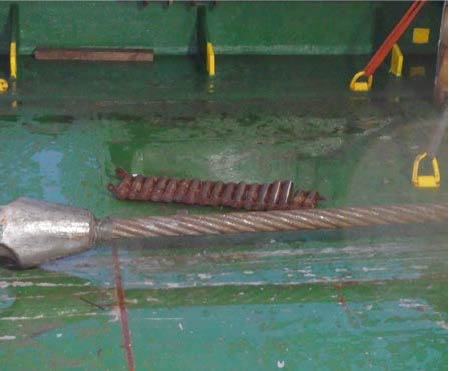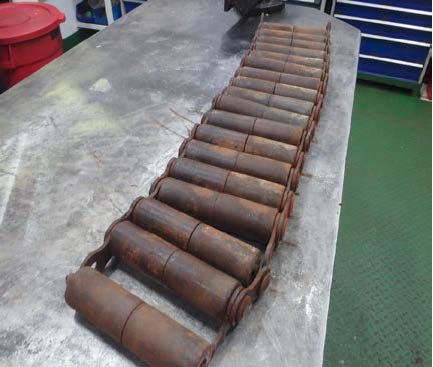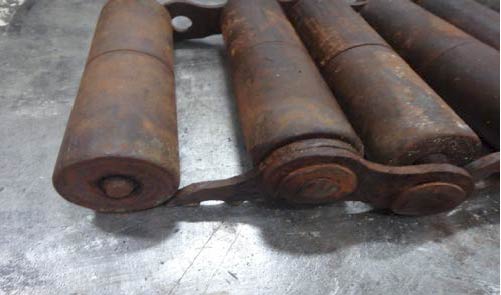High potential dropped object
A member has reported an incident in which an object fell 10m onto the main deck of a vessel. The incident occurred during pipe spooling operations on a vessel. Deck crew observed the object fall 10 metres from the ramp structure into the barriered area of the main deck. An ‘all stop’ was called and the object was found to be a ‘Hilman Roller Chain’ which weighed 60kg. This incident has been classified as having high potential and was reportable under local regulatory requirements.
Thorough risk assessment, in addition to the fact that crew followed the correct control measures, meant this particular incident was injury free. However, one roller, weighing 2kg, was found outside the barriered area and this alone, hitting someone from a 10m height, could easily have resulted in a fatality.



Our member’s investigation revealed the following:
- The Hilman Roller Chain parted and dropped as a result of an ‘8’ Link Plate failing and allowing the chain sections to part;
- A single roller weighing 2kg, dislodged from the chain assembly and was found to have landed outside the barriered area;
- The cause of the failure was not identified; however several factors including maintenance procedures, accessibility and seizure by corrosion may have been contributory factors.
The following lessons were identified:
- Dropped object surveys and sweeps should be proactively carried out, with secondary hold-backs installed (where required) and regularly checked; . Control measures (e.g. Permits to Work, Risk Assessments and barriers) are important factors in reducing risks and should be followed;
- Further detailed inspection of vessel equipment, maintenance procedures and working practices were to be conducted;
- Pre-use user visual inspections of all equipment should also be carried out. These should not merely be a cursory glance but a thorough visual examination. This does take time but the consequences of not doing this, as evidenced by this incident, where the dropped object weighed 60kg, could be catastrophic. Where it is not feasible to carry out a close visual inspection (due to height or inaccessibility of equipment) it should still be possible to inspect the area and/or the equipment. For example, are there nuts, bolts etc, under the equipment that could have dropped from it? Is there something that doesn’t look right i.e. equipment is distorted, or at the wrong angle etc?
Our member took the following actions:
- Area was made safe and a DROPS sweep conducted for further potential dropped objects, in immediate area and vessel-wide;
- Rope Access Team deployed to check integrity and function checking of all Hilman Rollers;
- Review of maintenance and other procedures and working practices to be reviewed and updated as necessary;
- All personnel reminded that not only can anyone call an ALL STOP, but they are obliged to call an all stop if they see any act or condition they consider is, or may be, unsafe;
- When positioning barriers, the ‘Cone of Exposure’ theory should be used to account for all DROPS potential (including direct drops, items rebounding items from structures, etc).
Our member notes that in Q4 2014 it experienced three high potential dropped object incidents, and that dropped objects remain one of the most common causes of major injuries in the workplace. These lead to cuts, bruises, head injuries, back injuries and fractures but some prove to be fatal.
Similar dropped object incidents are covered in nine of the nineteen 2014 Safety Flashes published, as follows: 03/14, 04/14, 08/14, 09/14, 13/14, 14/1, 15/14, 16/14, 18/14.
Members are reminded of IMCA promotional material as follows:
- Avoiding dropped objects (pocket card)
- Avoiding dropped objects (poster)
Safety Event
Published: 16 January 2015
Download: /home/storm/sites/dev-imca-int-com-1/public/wp-content/themes/imca-website-2020/single-safety-events.php on line 55
">
IMCA Safety Flashes
Submit a Report
IMCA Safety Flashes summarise key safety matters and incidents, allowing lessons to be more easily learnt for the benefit of all. The effectiveness of the IMCA Safety Flash system depends on Members sharing information and so avoiding repeat incidents. Please consider adding safetyreports@imca-int.com to your internal distribution list for safety alerts or manually submitting information on incidents you consider may be relevant. All information is anonymised or sanitised, as appropriate.
IMCA’s store terms and conditions (https://www.imca-int.com/legal-notices/terms/) apply to all downloads from IMCA’s website, including this document.
IMCA makes every effort to ensure the accuracy and reliability of the data contained in the documents it publishes, but IMCA shall not be liable for any guidance and/or recommendation and/or statement herein contained. The information contained in this document does not fulfil or replace any individual’s or Member's legal, regulatory or other duties or obligations in respect of their operations. Individuals and Members remain solely responsible for the safe, lawful and proper conduct of their operations.
